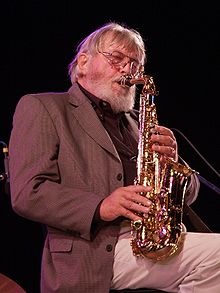
Our last work together was in January (4 nights at L.A.'s Jazz Bakery). Some very memorable tracks were recorded that week and I hope they see release some day. Bud was always willing to let the music “go where it wants" and set minimum “controls" on the players. His enthusiasm, optimism, laugh, and sense of humor, were a delight (after moving to Arizona he bought a truck and installed his no-more-used clarinet in the rifle rack!). I will miss the man very much.
Shank was inconvenienced by the pulmonary problems that restricted his mobility the past couple of years. He spent more time in a wheel chair than suited him. Nonetheless, he traveled long distances to perform, as far as Japan, maintaining the vigor of his playing and the essential buoyancy that dominated his personality.
Over the years, we worked together on projects and I spent considerable time with him. When I was researching the long essay that became the booklet for the 1998 Mosaic box set The Pacific Jazz Bud Shank Studio Sessions (limited edition, long since sold out), I stayed with Bud and Linda Shank at their house in the woods near Port Townsend, Washington. Here's a passage that says something about the man and about his lack of self-deception.
If the child is father to the man, then the thin, crew-cut diffident, inward-looking Bud Shank begat his opposite number. His substantial figure comfortable on a couch in a music room above a spacious lawn surrounded by tall pines, Shank agreed to do something he detests, look backward in music. With a mane of grey hair and a beard that squares off a solid jaw he has the look of a Victorian sea captain. His appearance is appropriate to the history of the seafaring town he lives in, but one floor below is a garage containing his collection of Porsches and an Infiniti Q45. Shank's laugh comes often and usually accompanies strong opinions. It has resonance and a certain wryness. I persuaded him to listen to “Bag of Blues," Bob Cooper's unusual composition from 1956.
When it was over, he said, laughing, “I was very young at the time. Formative period. Still learning. Still searching. I could see evidence of some of those influences we talked about. Spots of Zoot Sims, spots of Lee Konitz, spots of Charlie Parker.I told him, “When you were listening to yourself play a double-time passage, you said, 'Show-off.'"
“Well, yeah, but I really wasn't showing off in those days. It came from some musical reason but it didn't fit the flow of what I was doing before or after. I guess that's why it disturbed me. Again, that's the mish-mosh of different influences that were in me in those days. I didn't have it together yet.
Later, that night, or maybe the next day, we talked about his rise to fame in the 1950s when Los Angeles, always a good jazz town, became the center of what commercial interests and some critics decided was a school or movement. Shank's quartet then had Claude Williams on piano, Don Prell on bass and Chuck Flores on drums.
With the exception of those caught in the war between beboppers and moldy figs that was manufactured by know-nothing critics in the 1940s, no musicians have been more unfairly typecast than the young jazz players of Los Angeles in the 1950s.
“Neither Claude nor Chuck nor I was playing what was know as 'west coast jazz' music at that time," Shank said. 'That happened a few years before then and we were all breaking away from that."“Meaning what?" I asked. “What were you breaking away from?"
“The very delicate way that we all played in earlier years..." He stopped in mid-sentence. “I don't even know what the hell west coast jazz is," he said, with exasperation and no wry laugh. “It was something different from what they were doing in New York, so the critics called it west coast jazz. That Miles Davis Birth Of The Cool album, out of New York, probably started west coast jazz. It was also very organized, predetermined, written. It was a little bit more intellectual, shall I say, than had happened before. Jimmy Giuffre, Buddy Childers, Shorty Rogers, Shelly Manne, Marty Paich, Bob Cooper, almost everybody involved; we all came from somewhere else, New York, Texas, Chicago, Ohio. The fact that we were in L.A. around the orange trees had nothing to do with it. I really think that everybody played the way they would have played no matter where they were. New York writers, they're the ones who invented west coast jazz."
“Those bastards," I said.
“Those bastards," he said, laughing uproariously.
It was a source of frustration to Shank that, for many listeners who didn't keep up with music, his flute playing defined him. During his membership in the Lighthouse All-Stars in the fifties, he became one of the best jazz flutists in the world.
“I had always thought of myself as a saxophone player," he told me, “but the flute thing just appeared and all of a sudden, it was 'Oh, flute, flute, Bud Shank, flute,' which didn't sit too well, but at least people were noticing me, so, okay, let's keep on doing it. I was a saxophone player. That's all I'd ever thought of."
He did a lot of flute playing in the sixties and early seventies, when rock and roll stifled opportunities in jazz and he supplemented his income with studio work. Shank is still a model for many who play the instrument. He disposed of the flute in the mid-seventies, along with his career in the studios. “From now on," he said, “I'm a bebop alto player." As he concentrated on the saxophone, the aggressiveness, even ferocity, of his playing expanded along with the size of his sound and a magnificent feeling of liberation.
What a bebop alto player he was.



























